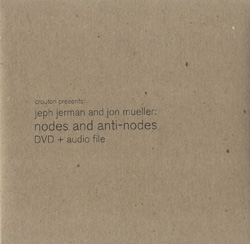
Choosing to issue music in DVD form, with visual content, opens up a wide range of possibilities as well as pitfalls. Short of simply filming musicians in action, you run the risk of introducing elements that may fall short of the images otherwise flowing through the listener's mind, may be redundant, may overpower the music. You might also demystify the sound sources involved, which may be a good or bad thing, depending.
Fans of the music of Jerman and Mueller are aware of their matter-of-fact approach to sound generation so, on the face of it, a video that consists largely of non-moving, close-up shots of the various pieces of metal, wood, bone, etc. being excited would seem to comport well with their attitude. And it does, to an extent. The film pretty much intersperses soundless or very quiet shots of the odd everyday nook and cranny, branches, shadows, peeling walls and such with episodes of sound, all more or less percussive in nature. In the latter cases, the camera is trained in closely enough so that one doesn't see the human interaction with the equipment, no hands or feet, just the immediate area being agitated. The first, for example, consists of a couple dozen, tightly coiled metal wires, maybe 1/16 inch thick, arrayed in a row from top to bottom of the screen, rapidly vibrating against some resonant surface. Whether they're being so excited by hands or machine, one can't tell since only the middle twelve or so inches are shown. They rattle attractively and one can see "waves" generated between them as they interact with each other. Next, after a soft interlude where one can just pick up some chimes, we see a close-up of the intersection of four clam shells, presumably on a shaking table, set a-clattering against each other and the surface. This one has a subtle humor about it, the shells acting like nervous biddies exchanging gossip. Sometimes, as on the third section (node?), one sees the object being set upon (it appears to be the surface of a gong) but not the means being used; one simply hears the ensuing drone. So it goes. Stirred vertebrae, vibrating trios of round black rocks, bent aluminum plates atop a cracked, pulsating cymbal, a hyperactive wooden bead strung on a taut piece of twine.
Seeing and listening to these events on video serves to distance one somewhat. You can't experience the sounds in the room in which they were recorded where their complex nature would interact with walls and other surfaces to form a kind of web wherein there would be many areas to focus one's attention and within which one could move about. Instead, you're focused on one image and one relatively narrow set of sounds emerging from your speakers. Also, though presumably a collaboration, as far as one can tell the elements of each segment seems to be instigated by a single individual-who knows what discussion took place beforehand?-and there is no obvious interaction between Jerman and Mueller. As such, the pieces take on the character of acoustic experiments: this is what happens when these objects are placed in this circumstance. You may find yourself yearning for more air, more freedom of movement, perhaps for a multiple of these situations happening at once, subject to change at the hands of the two participants. It takes a level of concentration on the part of the listener/viewer to just accept what is presented and to try and perceived it deeply, a task more difficult in the DVD medium than when experienced live, but doable with enough perseverance. In this case, the contents can be downloaded as an audio file onto one's computer, perhaps restoring some amount of mystery. Still, "Node and Anti-Nodes is an intriguing experiment, one that should appeal to fans of both musicians even if, at the end of the day, you'd rather hear them improvising together.
Comments and Feedback:
|



